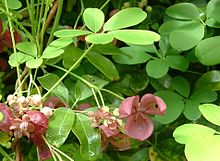You can help expand this article with text translated from the corresponding article in Spanish. (December 2009) Click [show] for important translation instructions.
|
| Lardizabalaceae Temporal range: Early Cretaceous–Recent
| |
|---|---|

| |
| Akebia quinata | |
| Scientific classification | |
| Kingdom: | Plantae |
| Clade: | Tracheophytes |
| Clade: | Angiosperms |
| Clade: | Eudicots |
| Order: | Ranunculales |
| Family: | Lardizabalaceae R.Br.[1] |
| Genera | |
|
See text | |
| Synonyms | |
| |
Lardizabalaceae is a family of flowering plants.
The family has been universally recognized by taxonomists, including the APG II system (2003; unchanged from the APG system of 1998), which places it in the order Ranunculales, in the clade eudicots.
The family consist of 7 genera with about 40 known species[2][3] of woody plants. All are lianas, save Decaisnea, which are pachycaul shrubs. The leaves are alternate, and compound (usually palmate), with pulvinate leaflets. The flowers are often in drooping racemes.
They are found in eastern Asia, from the Himalayas to Japan, with the exception of the genera Lardizabala and Boquila, both native to southern South America (Chile, and Boquila also in adjacent western Argentina). The extinct genus Kajanthus is known from the Early Cretaceous of Portugal.[4]
- ^ Angiosperm Phylogeny Group (2009). "An update of the Angiosperm Phylogeny Group classification for the orders and families of flowering plants: APG III" (PDF). Botanical Journal of the Linnean Society. 161 (2): 105–121. doi:10.1111/j.1095-8339.2009.00996.x. hdl:10654/18083. Retrieved 2013-07-06.
- ^ Christenhusz, M. J. M. (2012). "An overview of Lardizabalaceae". Curtis's Botanical Magazine. 29 (3): 235–276. doi:10.1111/j.1467-8748.2012.01790.x.
- ^ Christenhusz, M. J. M.; Byng, J. W. (2016). "The number of known plants species in the world and its annual increase". Phytotaxa. 261 (3): 201–217. doi:10.11646/phytotaxa.261.3.1.
- ^ Mendes, Mário Miguel; Grimm, Guido W.; Pais, João; Friis, Else Marie (2014-10-02). "Fossil Kajanthus lusitanicus gen. et sp. nov. from Portugal: floral evidence for Early Cretaceous Lardizabalaceae (Ranunculales, basal eudicot)". Grana. 53 (4): 283–301. doi:10.1080/00173134.2014.932431. ISSN 0017-3134.